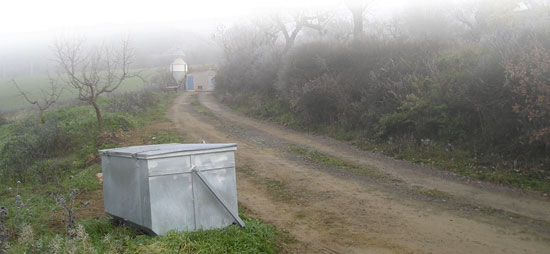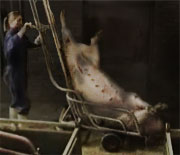It is very frequent that the producers write down a single cause for the culling of the sow. It is also frequent that the culling is normally associated with a cause, generally predetermined in the management program, and that in many cases no health/disease cause is considered because, on the other hand, the staff that normally makes a note of them does not have enough training. In fact, most frequently, the entry is based on external signs without considering internal lesions or diagnoses of any kind.
On this basis, data are processed in the best possible way (although, generally, starting with an incorrect database due to the errors in the data collection), and important management or health related decisions are taken. This situation provides us with nothing, given the great uncertainty on which it is based, and, in fact, the scarcity of good quality studies in this area is easily understandable based on what we have said previously.

So, it seems quite necessary to promote a standardization of the causes for the culling of the sows that are, on one hand, consistent in themselves, and that, at the same time, allow us to make comparisons between farms. We want, from here, to propose some rules on which this standardization can be based:
|
1. Kind of loss:Distinction between dead sows and culled sows. The difference is easy: we will find the dead sow at the farm (due to a sudden death or to a chronic disease or lesion). The culled sow could be actually sent to the abattoir or could be euthanized at the farm during the waiting period for its sending to the abattoir (paradoxically, the latter are not normally considered as sent to the slaughterhouse).  |
||||
| a. Old, age. It must never be considered as valid before the 5th farrowing, when the sow reaches its maximum size. We think that this cause is acceptable. b. Infertility. Only if two oestrus cycles have passed after weaning (45 d), with the sow having been mated. c. Anoestrus. If they have not been mated at least 8 d after weaning. d. Body condition. Only if the score is 1 or 2, but it is necessary that the farm records this routinely: nevertheless it is infrequent. e. Productivity. It is difficult to determine the threshold for this parameter, that also depends greatly on the farm, so our suggestion is only that it is "reasonable". The sow should always have farrowed twice at least. We find farms in which many gilts are recorded under this cause (low productivity), whose causes are to be found in the management, rather than in the sow. f. Health reasons. Given their importance, it is convenient to distinguish them minimally, because doing it well entails a very high return in the handling and health management practices. The most frequent ones are: |
||||
| i. Intestinal torsion. It must not be recorded as such if a necropsy is not performed. ii. Clostridium. It must not be recorded as such if a necropsy is not performed. iii. Prolapse. iv. Lameness. It is the most frequent cause, and it is rising in many farms. It is multifactorial, because it depends on many factors: nutritional, handling/management (group size, static-dynamic), premises (kind and condition of the slats) or genetic. If it entails a problem it is convenient to record it carefully, at least during the time that the problem is out of control. We recommend to make a note of, at least: |
||||
| 1. Limb lameness (above the hoof) 2. Injured hooves 3. Lost hooves 4. Overgrown hooves 5. Injured foot pads 6. Joint abscesses |
||||
| 3. Avoid, when possible, the cause "Others": it is preferable to write down "sudden death": this means that the death is sudden and due to an unknown cause, because a necropsy has not been performed. The higher the percentage of this kind of cause, the worse the quality of the registers. | ||||
What is the relationship between what is written down and what really happens? Stalder et al. (2007) carried out an excellent practical review after examining almost a thousand sow carcasses at the abattoir, concluding that almost a fourth were not recorded correctly in the registers. The main conclusions were as follows:
| • ‘Age / Old’: It showed a 19% of errors in the recorded sows (broken down in a 12% due to infertility, 4% of them were young sows, and 3% suffered both causes). • Sows of any parturition (1st-13th) were sometimes recorded as Age / Old. • ‘Infertility’: A 28% of the real cases were recorded incorrectly: almost all of them (88%) after only one heat after which the sow did not become pregnant (and so they were not two failed matings, as we suggested before). • ‘Anoestrus’: Was recorded quite well (6% of errors). • ‘Body condition’: It was recorded incorrectly: 34% of the times with scores over 3 (and not 1 or 2, as we explained before). • ‘Productivity’: It entailed a 32% of the sows recorded incorrectly, because their productivity was higher than the average in the study. |
 The conclusions derived from the experience at the farms and from studies as the aforementioned one are quite clear. In many cases we write down few causes, and badly, because we have a badly structured records system, and we must add to this that on many occasions the staff at the farms is not well trained enough.
The conclusions derived from the experience at the farms and from studies as the aforementioned one are quite clear. In many cases we write down few causes, and badly, because we have a badly structured records system, and we must add to this that on many occasions the staff at the farms is not well trained enough.
Given the current situation, in which the return of the investment on sows must be higher than ever, we frequently find percentages of cullings and of dead sows that are unnecessarily high and whose real causes we only get to imagine, so it is impossible to suggest reliable plans for the control of the problem.
Some simple guidelines concerning the registers and the staff, with a minimum training with respect to this, may imply the solution to the problem.



